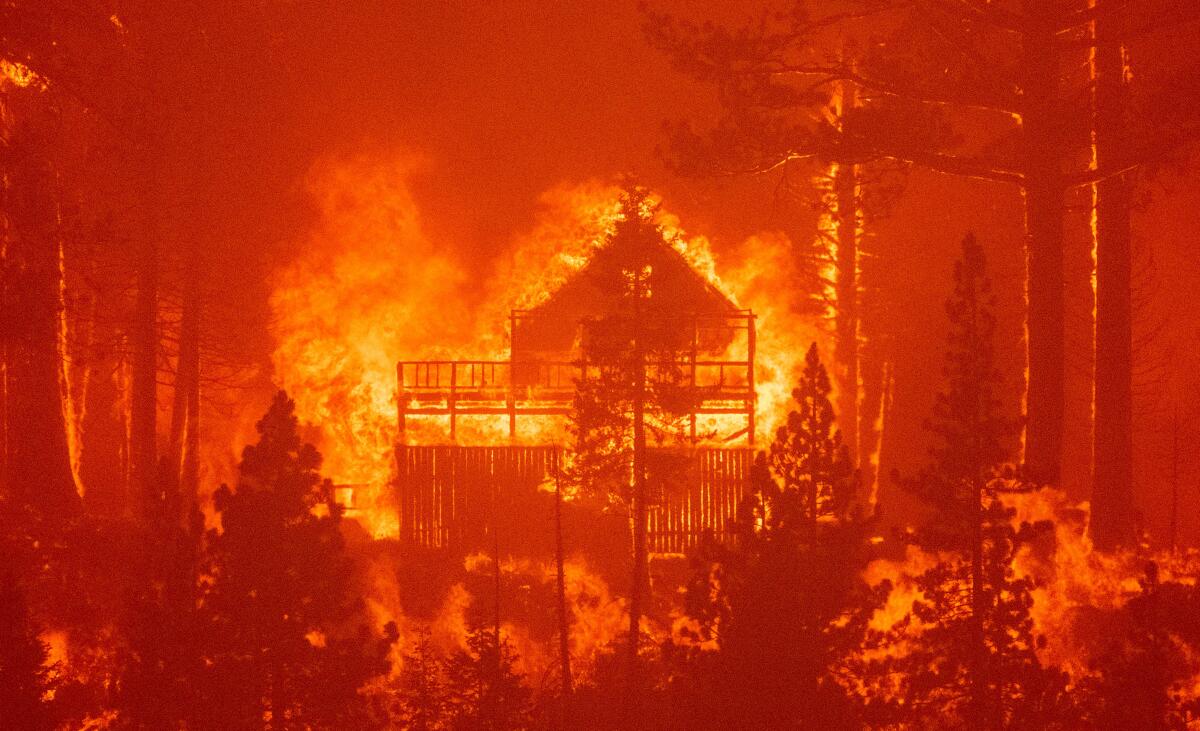Lake Tahoe is California’s gem. Climate change could devastate it

- Share via
Across the West, megafires are no longer uncommon, and unprecedented fire behavior is no longer unexpected. Welcome to the California of climate change, where the new normal is extreme weather and terrifying consequences.
Already, the 2021 fire season has confounded expectations. Before this year, no fire was known to have burned from one side of the Sierra Nevada to the other. Now it’s happened twice — with the Dixie fire in the northern Sierra and now the Caldor fire near Lake Tahoe. The Dixie fire is the second largest in state history and still burning.
On the Caldor fire, more than 4,000 firefighters have been working night and day to try and save communities around Lake Tahoe. Some 35,000 homes, hotels and other businesses are at risk if the fire takes a turn for the worse. Even if the properties and the city of South Lake Tahoe are saved, the landscape is scarred.
This is one of the most beautiful and beloved corners of California. And while Lake Tahoe’s dazzling blue hue will most likely return in time, there are real concerns about what lies ahead for the region’s ecosystem and economy if the calamity of this summer becomes a regular occurrence.
Countless researchers and government reports have warned for years that climate change would amplify natural variations in the weather, leading to more frequent and more destructive wildfires. The extremes are happening faster than many predicted or wished, and it’s clear that California isn’t prepared — and won’t be for a while.
There’s one reason the Caldor fire is so disturbing: State and federal authorities have thrown tremendous numbers of firefighters and resources into fighting this blaze and they haven’t been able to stop it. Plus, the Tahoe Basin is more prepared for wildfires than other regions in California. Authorities have spent millions of dollars over the last 15 years on prescribed burns and thinning projects to reduce excess vegetation that becomes fuel for a fire, according to the Sacramento Bee. The region has developed programs to make homes and yards more resistant to fire.
That is exactly what California should be doing. And yet it’s not nearly enough, as these two fires illustrate. The state is dealing with dangerous conditions created by climate change and exacerbated by more than a century of well-intentioned but ultimately damaging forest management.
The ecosystem once relied upon low-intensity fires to clear excess vegetation. But as logging took off and homes and businesses moved to the forest, authorities began putting out fires to protect lives and property. The forests are now dense with fuel that nature would have otherwise cleared out. Many areas have gone decades without fire. And when they finally do burn, it becomes a conflagration.
Despite the efforts to educate residents on how to make their homes more resistant to fire, there are still many older homes around Tahoe and other forest communities that have shake roofs and wood decks, surrounded by a carpet of dry pine needles. These conditions fuel extreme fires. And while there’s a lot of talk about what should be done, the reality is there’s not enough money, manpower or urgency to complete the mass retrofitting needed to help older communities withstand the new normal.
The path forward should be clear, even if it’s not easy. Of course, California should be doing much more, much faster to make communities resilient to wildfires. The state should stop sprawling in high fire-risk areas.
But these devastating wildfires should be a visceral reminder that the world has moved too slowly to stop climate change, and we are already feeling the effects of a warming planet. We can’t stop the megafires of today, but with radical action to phase out fossil fuels and slash carbon emissions we can help prevent even greater devastation in the coming decades.
More to Read
A cure for the common opinion
Get thought-provoking perspectives with our weekly newsletter.
You may occasionally receive promotional content from the Los Angeles Times.









